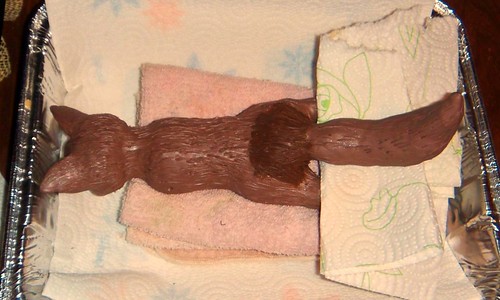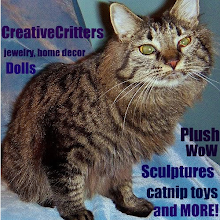
Even though I'll be adding more clay over most of this, I still textured the fur. This, along with a thin coating of tacky glue, will help the raw clay adhere to the baked clay. After baking for an hour and letting the piece cool completely, this is how he came out. No cracks, no sagging, no shifting- everything stayed right where it was supposed to.

This is basically just a form for me to build upon. Now that it's baked, it's much easier to handle, and I don't have to worry about accidentally squishing the fine details of his face. Next comes a layer of "fur" for his tail and hind legs. I'm modeling this guy after Calcifer, and he's got what I call fuzzy breeches. His legs and butt are very fluffy, and I like that effect and the way it looks. His tail is very furry and sort of feathery. I did my best to capture that in clay.

I used 3 different sized aluminum knitting needles to get this furry look. There's a lot of texture to Calcifer's fur, and I'll end up spending hours on just adding fur texture to this piece (not to mention all the time spent conditioning clay- lol). His arms come next. I made wire armatures, bent them in the right pose, and covered them with tacky glue. Once the glue was dry I shaped the arms, but made them smaller than the final size I want them to be. Once again, I'll be adding more clay after the arms are baked. You may notice that my clay isn't all the same color. That's OK for a few reasons. First, Calcifer has lots of different colors in his fur, and second, I'll actually be painting this one after he's finished. I learned some pretty cool painting technique from Katherine Dewey, and it's sometimes easier to paint an animal's color variations than it is to try to make clay in those exact colors and patterns.
This is a complex piece, which I'm figuring out as I go. Thanks for sharing the journey with me! Stay tuned to see how it turns out! =)
-Michelle of CreativeCritters








Wow, that is an intense amount of work! Coming along so nicely, too =)
ReplyDelete